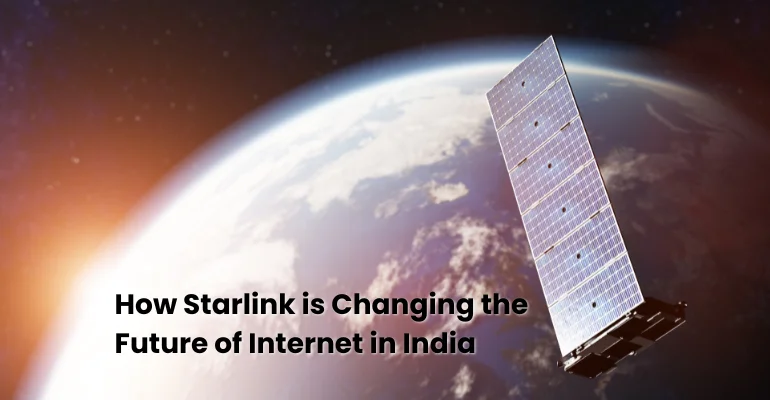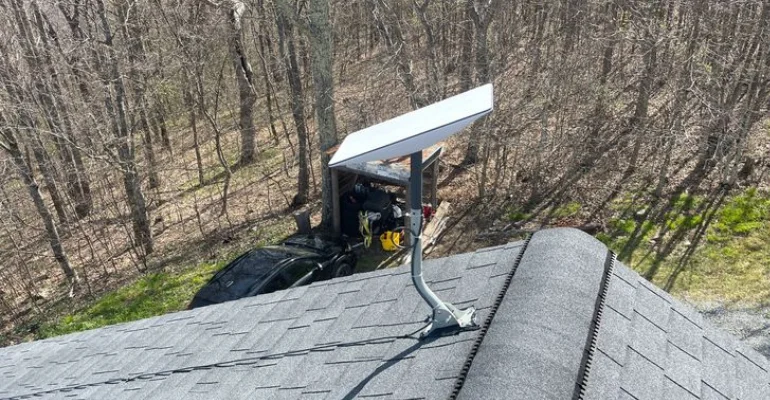How Starlink is Changing the Future of Internet in India—Price, Speed & Launch Details

Access to fast, dependable internet is now indispensable for education, business, healthcare, and everyday communication. Yet, millions of people, especially in remote and rural regions, continue to face limited or no internet access. Enter Starlink, an ambitious project by Elon Musk’s SpaceX, aiming to solve this global challenge. Now, with plans underway to launch Starlink services in India through partnerships with telecom giants Airtel and Jio, the country could soon witness a transformative leap in connectivity for underserved areas.
To provide high-speed, low-latency internet access to every corner of the planet, especially where traditional broadband can't reach.
Traditional internet services typically rely on underground cables or mobile towers, but Starlink takes a different approach, using a constellation of low Earth orbit (LEO) satellites to deliver internet directly to users. With thousands of satellites already in orbit and more being added regularly, Starlink is on track to revolutionize global internet connectivity, and India is next in line to benefit from this innovative satellite technology.
What is Starlink?
Starlink is a satellite-based internet service developed by SpaceX, the aerospace company founded by Elon Musk. Unlike traditional broadband, which depends on fiber cables, cell towers, or copper lines, Starlink delivers internet using a constellation of low Earth orbit (LEO) satellites that beam signals directly to users via a compact satellite dish.

Purpose of Starlink
Starlink’s mission is to make fast, reliable internet accessible anywhere in the world, especially in regions where traditional infrastructure is weak, expensive, or non-existent.
This is particularly relevant for India, where large rural and remote regions still struggle with poor connectivity or no internet access at all. Starlink has the potential to fill that gap, bypassing the need for ground-based infrastructure and offering a direct connection from space.
Target Audience in India
Starlink is designed to serve users who are underserved by existing telecom networks, such as:
- Rural villages and remote communities where broadband coverage is limited or completely unavailable
- Travelers, mobile workers, and digital nomads who require stable internet in off-grid or constantly changing locations
- Emergency response teams operating in disaster-affected areas where communication lines are often disrupted
- Students, freelancers, and professionals in semi-urban or developing regions where existing internet services are slow or unreliable
By bringing satellite-powered connectivity, Starlink could become a game-changer for India’s digital inclusion and rural development goals.
How Starlink Works
Starlink delivers internet not through cables or cell towers, but directly from space using thousands of Low Earth Orbit (LEO) satellites. This innovative system allows Starlink to provide high-speed internet even in regions where laying cables or building towers is difficult or economically unviable—something highly relevant in a geographically diverse country like India.

Low Earth Orbit (LEO) Satellites
Starlink satellites orbit much closer to Earth (around 550 km altitude) compared to traditional communication satellites. This low orbit reduces latency, or signal delay, enabling smoother video calls, faster downloads, and responsive online gaming—essential for modern digital needs.
Ground Equipment: User Terminal & Dish
To access Starlink internet, users need a Starlink Kit that includes:
- A compact dish antenna (also called "Dishy")
- A Wi-Fi router
- Necessary cables and mounting gear
The dish automatically aligns itself with the nearest satellites overhead, requiring only a clear view of the sky. This makes it ideal for homes, schools, farms, and businesses in rural or semi-urban Indian regions.
In India, where rural connectivity still faces hurdles due to terrain, cost, and lack of infrastructure, Starlink could emerge as a transformational solution to bridge the urban-rural digital divide.
The Starlink Satellite Train
If you've ever looked up at the night sky and seen a straight line of glowing dots slowly moving together, you may have witnessed a Starlink satellite train—a unique and awe-inspiring visual caused by newly launched satellites.

What is a “Satellite Train”?
After SpaceX launches a batch of Starlink satellites, they travel in tight formation for a few days to weeks as they gradually move to their final orbits. This group of satellites, visible in the night sky, resembles a
Why Do They Appear as Glowing Dots?
Each satellite reflects sunlight back to Earth, especially just after sunset or before sunrise, when the sky is dark but the satellites are still illuminated by the sun. The result is a line of bright, evenly spaced dots slowly gliding across the sky.
Public Reactions and Visibility in India
In India, sightings of the Starlink train have generated curiosity, amazement, and sometimes confusion. Many first-time viewers mistake it for UFOs, missiles, or some rare cosmic event. However, awareness is growing as more people learn about Starlink and its expanding satellite network.
You can even track when the satellite train will be visible from your location using astronomy apps or websites like FindStarlink.com.
Tip for Skywatchers in India: Clear skies in rural or low-light areas offer the best chance to spot a satellite train, usually within a few days after a launch.
Benefits of Starlink
Starlink offers a range of benefits that make it a promising solution for India’s long-standing internet connectivity challenges—especially in areas where traditional telecom networks struggle to reach.

1. High-Speed Internet in Rural and Remote Areas
One of the biggest advantages of Starlink is its ability to deliver broadband-level internet speeds—even in the most isolated parts of the country. Whether it’s a village with no fiber connection or a remote area with poor mobile signals, Starlink can bring fast and reliable internet without the need for ground infrastructure.
This opens doors to online education, telemedicine, e-commerce, and government digital services in areas previously considered unreachable.
2. Low Latency for Real-Time Applications
Traditional satellite internet (like geostationary satellites) suffers from high latency, making real-time activities like video conferencing, gaming, or online classes frustrating. Starlink's low Earth orbit system drastically reduces this lag, providing latency as low as 20–40 milliseconds, comparable to fiber broadband in urban areas.
3. Independence from Local Telecom Infrastructure
Unlike conventional internet that depends on cables, cell towers, and regional ISPs, Starlink works independently. All you need is:
- A Starlink kit
- Access to power
- A clear view of the sky
This makes it ideal for users who are tired of frequent outages, slow speeds, or lack of service from local providers.
Starlink Coverage and Availability
As of now, Starlink is active in over 70 countries, including the United States, United Kingdom, Australia, Canada, and parts of Europe and South America. Its footprint is expanding rapidly as more satellites are launched and ground infrastructure is developed.

Global Reach and Expansion Plans
Starlink’s vision is to create a global broadband network, especially for underserved and hard-to-reach areas. With over 5,000+ satellites already in orbit and many more planned, SpaceX aims to provide seamless coverage almost anywhere on Earth. Future plans include expanding to aircraft, ships, and moving vehicles, making Starlink a flexible option even in transit.
What About India?
In India, Starlink’s launch is pending regulatory approval. Although pre-orders began briefly in 2021, the Indian government asked SpaceX to halt bookings until it received the proper licenses.
As of 2025, there is optimism around Starlink’s upcoming launch, with progress being made on policy and partnerships to bring the service to Indian consumers.
Once approved, Starlink could significantly improve internet access in:
- Rural and semi-urban regions
- Educational institutions in underserved areas
- Border zones and remote government outposts
How to Check Availability in Your Area
You can check whether Starlink is available in your location by visiting the official website:
Just enter your PIN code or location, and the site will let you know if service is available or when it's expected to launch in your area. You can also sign up for email notifications to get updates when the service goes live in your region.
How to Get Starlink in India
While Starlink is not yet officially available in India as of 2025, it's expected to launch soon after receiving regulatory approval. Here's what Indian users can expect once it goes live, based on how Starlink operates in other countries.

Hardware Requirements
To access Starlink internet, users will need to purchase the Starlink Kit, which includes:
- A compact satellite dish (nicknamed “Dishy”)
- A Wi-Fi router
- Mounting tripod and power cables
- Instructions for setup
The dish automatically aligns itself with Starlink satellites overhead and requires only a clear view of the sky to function properly.
The kit is designed for easy self-installation and can be set up on rooftops, terraces, or open fields.
Estimated Cost in India (Expected)
While final prices for India are yet to be announced, based on global pricing, users can expect:
- Starlink Kit (one-time cost): ₹50,000 – ₹60,000 (approx.)
- Monthly Subscription: ₹7,000 – ₹8,000 per month
These rates may change depending on government approvals, taxation, and possible local partnerships.
Installation Process
The installation is mostly DIY and involves:
- Unboxing the Starlink kit
- Placing the satellite dish in an open area with a clear view of the sky
- Connecting the dish to the power and Wi-Fi router
- Downloading the Starlink mobile app (available on Android & iOS)
- Following the app’s guidance to align and activate the connection
Within minutes, users can begin accessing high-speed satellite internet—no technicians, cables, or complex setup required.
Note: Once launched in India, Starlink will likely provide customer support and resources in regional languages to make the onboarding process smoother for rural and first-time users.
The Future of Starlink
Starlink is not just about providing internet, it’s part of a larger vision by Elon Musk and SpaceX to transform how the world communicates, travels, and even explores space. While India stands to benefit significantly from Starlink’s rollout, its future impact stretches far beyond Earth.

Integration with Tesla and Smart Mobility
There is growing speculation and early technical groundwork suggesting that Starlink may eventually be integrated into Tesla vehicles. This would allow electric cars to have real-time satellite connectivity, enabling:
- Live navigation in areas with no cellular coverage
- Over-the-air software updates anywhere
- Streaming, entertainment, and autonomous driving support on remote routes
This could be particularly useful in India’s vast highway network, where many rural or hilly stretches lack mobile internet.
Role in Mars and SpaceX’s Bigger Plans
Starlink plays a strategic role in SpaceX’s long-term plan for Mars colonization. A reliable communication system will be essential for future missions to the Moon and Mars. In the future, Starlink satellites could form the basis of interplanetary internet, connecting astronauts, rovers, and bases on Mars with Earth in near real time.
Competition: The Space Internet Race
Starlink isn’t alone in this domain. Other major players are racing to build satellite internet networks, including:
- Amazon’s Project Kuiper
- OneWeb, a UK-backed initiative with Indian investment via Bharti Enterprises
- Telesat and China’s satellite internet programs
India itself is emerging as a key market and strategic launchpad for these players, especially with ISRO offering commercial satellite launch services.
Conclusion
Starlink: Transforming India's Digital Future with Global Satellite Internet
Starlink is more than just another internet service, it's a revolutionary step toward the future of global connectivity. By eliminating the need for traditional ground-based infrastructure, Starlink has the potential to deliver high-speed internet to every corner of the planet, regardless of location, terrain, or economic status.
In a diverse and vast country like India , where digital inequality still affects millions, Starlink could be a true game-changer . It opens the door to quality education, remote healthcare, and digital opportunities in rural and underserved regions that have long been excluded from the digital revolution.
Driven by Elon Musk’s ambitious vision, Starlink is not only focused on bridging the digital divide on Earth but also aims to pave the way for future human settlement on other planets. From powering online classes in remote Indian villages to enabling internet connectivity on Mars, Starlink represents a bold leap toward a universally connected world.
As India gears up to welcome this groundbreaking technology, the key question isn't if Starlink will roll out nationwide, but how fast we can adapt to harness its full potential and truly transform the way we live, learn, and connect.
Looking to Grow Your Startup Online?
Tectignis IT Solutions is one of India’s top companies helping startups and small businesses thrive with affordable, all-in-one growth solutions. We specialize in SEO services, Social Media Marketing, Website Development, and Google Ads Management — everything your startup needs to build a strong online presence. Bundle multiple services and get exclusive discounts, all under one roof.
Your Startup’s Complete Online Growth Partner — Tectignis Has You Covered.

